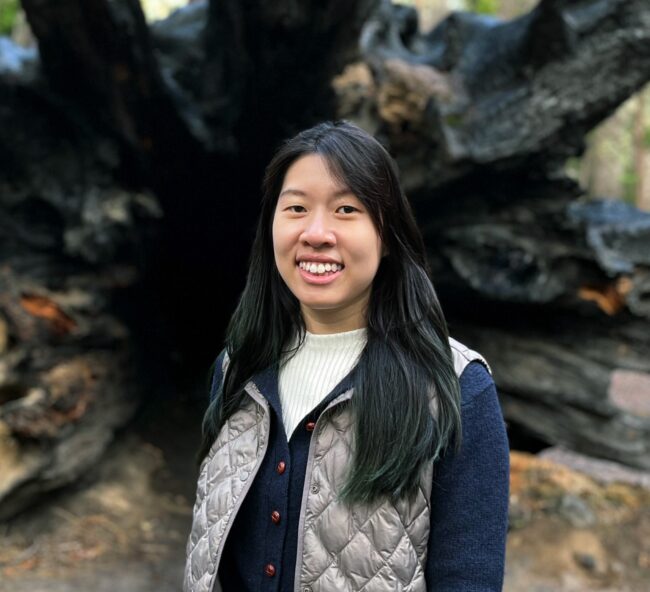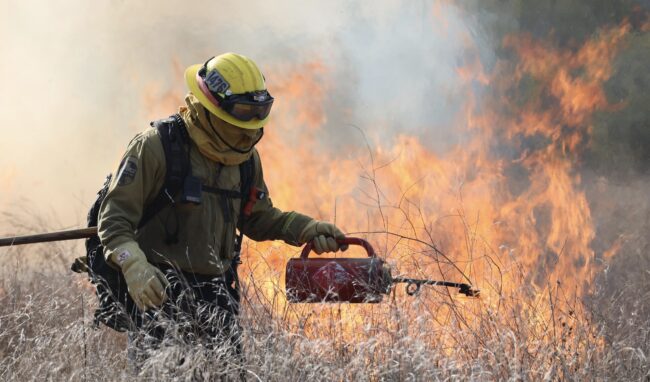As a Ph.D. candidate in the Department of Earth and Environmental Sciences at Columbia and Lamont-Doherty Earth Observatory, Caroline Juang is currently investigating how climate affects wildfires in the western United States—prescient in the face of the recent, catastrophic Los Angeles fires. She uses satellite data, big datasets and statistical modeling to try and understand such natural hazards in the context of modern climate. “Under human-caused climate change, the chances of wildfire-promoting conditions can only increase, since warm temperatures can become even warmer,” she says.
In the Q&A below, Juang discusses the importance of collaboration in scientific research; how she is motivated by her passion to increase access to opportunities in STEM; and the climate-related drivers of wildfire.

How did you get into science, and what is your area of focus?
Exploring as many things as possible through classes, field trips, and summer camps opened my eyes to the scientific world, with the help of my supportive parents. The little things in these programs—like watching a dragonfly emerge from its nymph shell into an adult dragonfly, and walking on a footbridge through a bouncy bog—inspired me to observe the world more closely. Applying for an internship at NASA Goddard Space Flight Center in 12th grade as a high school intern solidified my interest in Earth science—I was surprised to learn from my mentor that we can use satellites to track rain from space and help predict hazards! Working with landslides was my first real Earth science research experience.
Many years later, I was inspired to study wildfires in the western United States after witnessing the damaging effects of wildfires on human health and homes after the Thomas Fire and subsequent Montecito mudflows in 2018.

Though wildfires are important to some plants for helping with seed dispersal or for the soil, I’m learning from working with my Ph.D. advisor, Park Williams, about the climate-related drivers of wildfire. Warming and drying are driving bigger fires over the past few decades, on top of other conditions like fire management history and extreme weather. The L.A. fires are a devastating example of how many wildfire-promoting conditions together can lead to fast-growing wildfires—in this case, two wet winters that led to lots of vegetation growth as fuel for the fire this year; a very warm summer that dried out the fuel; and then an extreme wind event. As long as there’s an ignition source, the dice are stacked for fires to spread rapidly. My colleague Gavin Madakumbura, a postdoc at Williams’s lab, co-authored a great article explaining the LA wildfires. [You can read State of the Planet’s recent coverage of the fires here.]
“Science is not done alone. Engage with interesting science clubs, extracurricular activities or field trips where you can meet other women and girls who are passionate about science.”
Is there a woman in science, from Columbia or otherwise, who inspired you?
As a young student I looked up to Christa McAuliffe, U.S. teacher and astronaut. Reading and watching clips of her training to become the first teacher in space for the Challenger space shuttle mission, with a plan to share science experiments with students, was inspiring. Even though she never got to accomplish that dream, her determination and passion to teach science stuck with me and compels me to make my research accessible to students and the public and to inspire the next generation. At Columbia, I am inspired by the work of Dorothy Peteet, who graciously offers her time advising my committee when she’s not knee-deep in a marsh or out in the lake looking for signs of climate change and human history. She can look at microscopic seeds and pursue large questions of Earth’s climate history through both chemistry and scientific modeling. Her love for the wetlands she studies is captivating, and it carries through to her teaching and her work to preserve marshes.
Do you have any advice for younger women or girls who are interested in entering the field?
Science is not done alone. We collaborate on research questions and build upon past discoveries from more senior scientists. Engage with interesting science clubs, extracurricular activities or field trips where you can meet other women and girls who are passionate about science. In those spaces, you will always find mentors who would love to teach you, involve you in their work and help you find your own path. You will also be in a space to find allies and friends who you can find community with as you brave the challenges of a career in science.



No Comments
Leave a comment Cancel